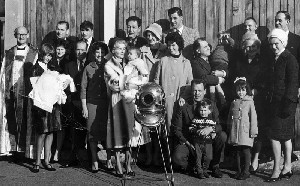
St. Adjutor's Church was perhaps the smallest, shortest lived and most exclusive church ever built on Portsea Island. It was erected at the Vernon Shore Establishment after World War 2 and was lost in the redevelopment of Gunwharf at the end of the century.
Lt. Cdr. R.J. Hoole MBA MCMI MIExpE MNI RN, of the Minewarfare & Clearance Diving Officers' Association has kindly provided some snippets of information about the church
"St Adjutor's was a tiny wooden chapel behind the administration building (now the Old Customs House pub) in HMS Vernon. I believe it was built in 1955 on the site of Dido building where 100 people were killed on the night of 10/11 March 1941 during the Blitz. It replaced the temporary chapel located on the ground floor of the administration building which had been in use since 1941.
Apart from departmental and general Sunday morning services, St Adjutor's was also used for the occasional wedding, christening and carol service at Christmas. It was demolished along with much of the rest of HMS Vernon to make way for Gunwharf Quays.

All three of my children were christened in a bowl of water placed in an inverted diving helmet used as a font. The diving helmet currently resides in St Barbara's at HMS Excellent on Whale Island. It sits upright on a tubular brass stand on which are mounted brass tallies listing all the divers' children ever christened in it. Sadly, years of polishing by enthusiastic vergers has worn away most of the inscriptions."
Extract from the Royal Navy Diving Magazine of 1968
"On Sunday 22nd September, 1968, the church of H.M.S. Vernon was dedicated to St. Adjutor by the Chaplain of the Fleet. Why St. Adjutor? And who was he anyway?
The church in Vernon had never been dedicated to any saint, and exhaustive research showed that there was no Patron Saint of Divers. The most appropriate was a St. Adjutor who was invoked by swimmers in danger of drowning, and by sailors and prisoners. The fact that he was born in Vernon-sur-Seine added interest and further research was made into details about him. He turned out to be a Vernon, and a member of the same family as Admiral Edward Vernon (Old Grog), 1684-1757, of Portobello fame, Admiral Sir Edward Vernon, 1723-1794, and the Hon. George Vernon. 1803-1866, whose figurehead is [was] outside the Administration Block in H.M.S. Vernon. The genealogy is in the Chaplain's Office, in case anyone is interested!
St. Adjutor was born in Vernon-sur-Seine, about 1070, the son of John, Seigneur of Vernon, and Rosamonde de Blairv. He joined the First Crusade, and left with 200 Knights, for the Holy land in 1096. The next year, they captured Nicaea, and advanced to Antioch in Asia Minor. It was near here that St. Adjutor's army fell into an ambush, and all seemed lost. He invoked St. Mary Magdalene, and promised to build a chapel to her honour in Vernon, if only his army could escape. A violent thunder-storm came up at once, which threw the enemy into such confusion that victory was achieved.
On 15th July 1099, St. Adjutor took part in the capitulation of Jerusalem, and he took the opportunity of visiting different Holy Places. On one visit he was captured by the Saracens and put with heavy chains into a cell. He spent many weary years there, till one night he had a dream. Mary Magdalene and St. Bernard appeared and snapped his chains off the wall; they carried him, with his chains, to his hunting lodge outside Vernon, and told him to build his chapel there. When he awoke, he was actually back in Vernon. (For a similar story, read the 12th Chapter of the Acts of the Apostles in the New Testament.)
The news spread of his sudden return, in circumstances attested by numerous Knights, and people started to ask for his help. He was by now living the strict life of a hermit, wearing a hair shirt and living on bread and water. He was supposed to have worked many miracles of healing, but his most famous was in the Seine opposite his cell.
The river narrowed here, and there was a notorious whirlpool which drowned the unworthy and engulfed their boats. St. Adjutor saw this happen, and determined with the assistance of his friend, Archbishop Hugo of Rouen to rid the Seine of this danger. They set out in a small boat, and as they were sucked into the pool, the Archbishop made the sign of the Cross, and sprinkled holy water. St. Adjutor called on Mary Magdalene and St. Bernard, and threw the chains of his captivity into the whirlpool. Front that moment, the whirlpool disappeared.
His reputation as a wonder worker increased, but he felt his power ebbing, and on 30th April 1131, he died after receiving the Last Sacraments from Archbishop Hugo.
Last month, two statues were given to our church, one of St. Adjutor about to cast his chains into the Seine, and the other of Mary Magdalene granting his request. Both are in bronze, and were made by Miss Ann Hughes of Twyford. The statues seem almost alive, and Adjutor in his hermit's shirt and Mary Magdalene in a 'mini-skirt' look real people, instead of plaster saints.
Last month, too, for the first time in Vernon's history, the Church of St. Adjutor was licensed for Banns and Marriages. At the end of June, it is hoped that three of Vernon's ships will visit Rouen and Vernon-sur-Seine to cement the relations started by that Vernon who has become our common patron saint. The Diving Section is well and truly represented by H.M.S. Laleston, which will remain at Rouen for the visit."
See Also
The History of HMS Vernon and Gunwharf
Vernon's French Connection